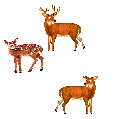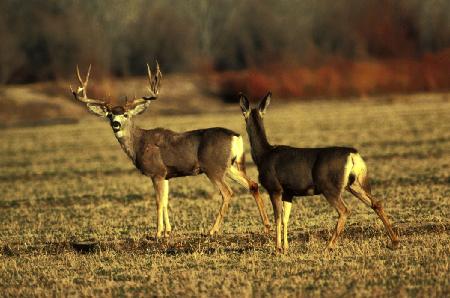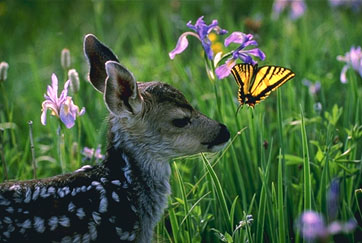|
|
Canku Ota |
|
|
(Many Paths) |
||
|
An Online Newsletter Celebrating Native America |
||
|
October 5, 2002 - Issue 71 |
||
|
|
||
|
Why the Deer Has No Gall |
||
|
|
 "It
was long, long ago, of course. All these things happened long ago when
the world was young, as you are now. It was on a summer morning, and the
Deer was travelling across the plains country to reach the mountains on
the far-off side, where he had relatives. He grew thirsty, for it was
very warm, and stopped to drink from a water-hole on the plains. When
he had finished drinking he looked up, and there was his own cousin, the
Antelope, drinking near him. "It
was long, long ago, of course. All these things happened long ago when
the world was young, as you are now. It was on a summer morning, and the
Deer was travelling across the plains country to reach the mountains on
the far-off side, where he had relatives. He grew thirsty, for it was
very warm, and stopped to drink from a water-hole on the plains. When
he had finished drinking he looked up, and there was his own cousin, the
Antelope, drinking near him.
"'Good morning, cousin,' said the Deer. 'It is a warm morning and water tastes good, doesn't it?' "'Yes,' replied the Antelope, 'it is warm to-day, but I can beat you running, just the same.' "'Ha-ha!' laughed the Deer--'you beat me running? Why, you can't run half as fast as I can, but if you want to run a race let us bet something. What shall it be?' "'I will bet you my gall-sack,' replied the Antelope. "'Good,' said the Deer, 'but let us run toward that range of mountains, for I am going that way, anyhow, to see my relations.'
"Away they ran toward the far-off range. All the way the Antelope was far ahead of the Deer; and just at the foot of the mountains he stopped to wait for him to catch up. "Both were out of breath from running, but both declared they had done their best, and the Deer, being beaten, gave the Antelope his sack of gall. "'This ground is too flat for me,' said the Deer. 'Come up the hillside where the gulches cut the country, and rocks are in our way, and I will show you how to run. I can't run on flat ground. It's too easy for me.' another race with you on your own ground, and I think I can beat you there, too.' "Together they climbed the hill until they reached a rough country, when the Deer said: "'This is my kind of country. Let us run a race here. Whoever gets ahead and stays there, must keep on running until the other calls on him to stop.' "'That suits me,' replied the Antelope, 'but what shall we bet this time? I don't want to waste my breath for nothing. I'll tell you-- let us bet our dew-claws.' "'Good. I'll bet you my dew-claws against your own, that I can beat you again. Are you all ready?--Go!'
"'Hi, there--you! Stop, you can beat me. I give up.' "So the Deer stopped and waited until the Antelope came up to him, and they both laughed over the fun, but the Antelope had to give the Deer his dew-claws, and now he goes without himself. The Deer wears dew-claws and always will, because of that race, but on his liver there is no gall, while the Antelope carries a gall-sack like the other animals with cloven hoofs.
Print and Color Your Own Deer
Picture |
|
|
|
Mule Deer (Odocoileus
hemionus)
|
|
A yearling buck usually has two points on each antler in he form of a "Y", while the adult buck has an additional "Y" at each point, which makes four points on each typical antler. Antlers remain hard and polished until they are shed in late winter. The remarkable process of antler growth is renewed in the spring and the cycle continues throughout the adult buck's life. The buck produces its largest set of antlers when it is about six years old. By early November a male fawn weighs about 81 pounds and a female fawn about 73 pounds. Yearling bucks average 140 pounds while does weigh about 15 percent less. Older bucks, with good nutrition, can weigh as much as 250 pounds or more. Distribution: Habitat and home: Although a mule deer is less likely to use
mature timber along stream courses, it may frequent timbered areas along
the upper reaches of small streams and creeks. Mule deer are also fond of wheat country, clover and sunflower patches, and small grain and alfalfa crops within their occupied range. Habits: Mating occurs in the fall, with bucks setting up territories based on dominance, and busily trying to locate does. In the fall the buck's antlers are hardened and polished, and he uses them to defend his territory and protect his does. Most mating is concluded by the time winter sets in. If the winter is severe with low temperatures and deep snows, the deer "yard up", or gather together, in areas that provide for most of their needs. Many deer in a group are able to break trails in deep snow more efficiently than a single deer can, which allows each individual to conserve needed energy to fight off the cold. Foods: Reproduction: Does are in heat for about 24 hours, and cycle every 28 days if they are not bred. Fawns are born after a 202 day gestation period, with about half of the young being born between late May and late June. The mule deer's reproductive rate of 94 fawns per 100 does is low compared to the whitetail's 140 fawns for every 100 does. Sexual maturity is slow in mule deer and only seven percent of the does breed when they are fawns and only 68 percent of yearling does become pregnant. About 65 percent of pregnant mule deer does carry twins compared to 82 percent of whitetail does having multiple births. Importance: Unfortunately, the mule deer's fondness for agricultural crops can lead to problems where deer populations are high. Winter concentrations can cause substantial damage to stored crops, although protective measures such as location selection, fencing, and repellents can reduce these losses. Legal harvest, through hunting seasons, continues to be the major tool employed by wildlife managers to reduce deer populations to minimize problems suffered by landowners. |
|
|
||
|
|
||
| Canku Ota is a free Newsletter celebrating Native America, its traditions and accomplishments . We do not provide subscriber or visitor names to anyone. Some articles presented in Canku Ota may contain copyright material. We have received appropriate permissions for republishing any articles. Material appearing here is distributed without profit or monetary gain to those who have expressed an interest. This is in accordance with Title 17 U.S.C. section 107. | ||
|
Canku Ota is a copyright © 2000, 2001, 2002 of Vicki Lockard and Paul Barry. |
||
 |
 |
|
|
The "Canku Ota - A Newsletter Celebrating Native America" web site and its design is the |
||
|
Copyright © 1999, 2000, 2001, 2002 of Paul C. Barry. |
||
|
All Rights Reserved. |
||
 "'All
right,' said the Antelope. 'All ready, and here we go.'
"'All
right,' said the Antelope. 'All ready, and here we go.' 
 Mule
Deer have large ears that move constantly and independently, from whence
they get their name, "Mule" or "Burro Deer." They
do not run as other deer, but have a peculiar and distinctive bounding
leap (stotting) over distances up to 8 yards, with all 4 feet coming
down together. In this fashion, they can reach a speed of 45 m.p.h.
for short periods.
Mule
Deer have large ears that move constantly and independently, from whence
they get their name, "Mule" or "Burro Deer." They
do not run as other deer, but have a peculiar and distinctive bounding
leap (stotting) over distances up to 8 yards, with all 4 feet coming
down together. In this fashion, they can reach a speed of 45 m.p.h.
for short periods. Mule
deer are most active during dawn and dusk, when they venture from protective
cover when it is time to feed. In the spring each doe moves off by herself
to select a fawning area, and a buck becomes solitary or joins a small
group of bachelors as his antlers develop. Most fawns are born in early
summer. The fawn's survival strategy is based on its protective coloration,
its ability to remain motionless as danger approaches, and its small
amount of scent which makes finding it difficult for predators. The
doe leaves her fawn unattended while she feeds, but stays in the vicinity,
returning only to nurse the fawn. This behavior leads some well-intentioned
people to think a bedded fawn has been abandoned, when in reality the
doe is close by and probably watching. The best thing to do if you encounter
a fawn is to leave the area and allow the doe to return and move her
fawn to a safe location.
Mule
deer are most active during dawn and dusk, when they venture from protective
cover when it is time to feed. In the spring each doe moves off by herself
to select a fawning area, and a buck becomes solitary or joins a small
group of bachelors as his antlers develop. Most fawns are born in early
summer. The fawn's survival strategy is based on its protective coloration,
its ability to remain motionless as danger approaches, and its small
amount of scent which makes finding it difficult for predators. The
doe leaves her fawn unattended while she feeds, but stays in the vicinity,
returning only to nurse the fawn. This behavior leads some well-intentioned
people to think a bedded fawn has been abandoned, when in reality the
doe is close by and probably watching. The best thing to do if you encounter
a fawn is to leave the area and allow the doe to return and move her
fawn to a safe location.  The
mule deer's breeding season begins in October and ends in early February,
with the peak occurring in mid to late November. This is also referred
to as the "rut", a time when the buck's neck swells and he
fights other bucks for dominance. A single buck is capable of breeding
several does.
The
mule deer's breeding season begins in October and ends in early February,
with the peak occurring in mid to late November. This is also referred
to as the "rut", a time when the buck's neck swells and he
fights other bucks for dominance. A single buck is capable of breeding
several does.